Esports Part Three - Factors Driving the Ultimate Esports Experience
Lossless, near zero latency video signals are key to the esports experience. No lag time — for players or the audience — means lighting fast reaction times from the gamers and immediate responses from the spectators viewing in real-time on public displays.
In addition to great audio and video, integrating various devices is a priority, such as mouse and keyboard peripherals, headsets, cameras on the gamers themselves, and other considerations.
Sources and peripherals can be either dispersed or centralized. Signals, including USB protocols, must be transmitted over long and short distances bidirectionally with optimal precision and no lag time. Any delays between the commands sent through an interface and the return response will impact the gaming experience negatively.

Video Processing and Performance
Clarity is critical for any esports venue, from small labs to large arenas. Every detail helps the gamer to make real-time decisions within the game, helps moderators to monitor and control the in-room experience, and makes for a more robust spectacle for the audience. To act decisively, the gamer must be able to see clearly.
Lower resolutions, color loss, ghosting, and lag time need to be addressed and resolved as they will negatively impact the experience. The quality of the video cannot be compromised.
Compatibility becomes paramount as signals can only travel so far with high levels of integrity before loss occurs. Video signals require format switching over various extenders to “push” the signals. Each point of signal conversion is a potential point of delay and failure. This extends to complimentary devices such as displays that are critical to the application’s success.
Intuitive User-Experience
While enabling technologies deliver the high levels of functionality needed here, intuitive control over the technology is a big piece of the puzzle. Technology is only as good as how it’s used, and layering in seamless control for gamers, moderators, and even the spectators is the element that truly brings the ultimate experience to life.
That means controls will be needed for the following:
For Gamers:
-
Source/game selection
-
Volume, climate, headset, display, and other adjustments
For Moderators:
-
Source selection to feed content to main displays (including audio levels)
-
Venue climate controls
-
Communication monitoring (between gamers and between the gamers and moderator)
-
Camera selections on gamers
For Spectators:
-
Gamer selection for viewing (who does an audience member wish to “follow"?)
-
A general high-definition viewing and audio experience for seeing and hearing the gamers — just like at professional sporting events
Audio processing and performance
Audio clarity is just as important as the video image. The ability to hear everyone and everything in high fidelity makes for both a better gaming and spectator experience.
Speech audio must be intelligible as gamers communicate with each other and the moderator. Audio must capture all the high and low frequencies. Background and ambient noise must be filtered.
Any proper audio solution will need to:
-
Silo audio for individual experiences, and group audio to open spaces
-
Mix multiple audio sources, such as microphone and content audio
-
Separate and individually select audio and video (digital audio is tied to the video signal, so the ability to embed and/or de-embed the audio signal from the video signal is important)
-
Include an option to route audio to a recording device

Security
When it comes to security in an esports environment, the key components that need to be addressed are content encryption, device access and user access.
Part of the experience for the esports venue is to protect the games from piracy. While the games themselves are protected, the distribution platform must be able to support the most aggressive compliance and risk mitigation standards that are layered on top of the “stock” protection the game carries with it.
Any high-demand video application should leverage all the latest enterprise-grade security protocols, such as 802.1x and TPPS, and will remotely update security patches as they become available.
Higher degrees of certifications — even military grade certifications — should be carefully identified for another layer of confidence. JITC, NIAP, or FIPS certifications protect network infrastructure, the protected gaming content, and all connected devices and the data they hold.
A robust security package should provide:
-
Control over the application and environment that drives the experience
-
The ability to select specific games/stations to be displayed on a public screen or video wall
-
The ability to adjust environmental settings like audio levels, lighting, and camera feeds
-
The ability for a moderator to monitor the gamers themselves for proper behavior (e.g. listening in on chats)
Management
The larger a venue becomes, the greater the need to be able to manage, monitor, and troubleshoot the system. The right management tool — especially one that has the ability to fix issues remotely, is an incredibly powerful asset.
A proper management system should provide the ability to:
-
Deploy, manage, monitor, and troubleshoot platforms remotely
-
Expand the system and add new endpoints efficiently
-
Update firmware or software when you want (and when going onsite is not possible or safe)
-
View system health and to get conditional alerts (empowering you to address potential issues before an emergency or during a critical operation, as maximizing system uptime is paramount)
-
Manage each asset on the platform
-
Provide notifications with regard to license statuses and device life cycles

If you’re interested in learning more — including descriptions of the various venues, small to large, and their technological needs — see Crestron’s new eBook, “Planning for the Ultimate Esports Experience.”
Read more: Esports Part One — An Introduction
Read more: Esports Part Two — Where Are Esports Played?
SUBSCRIBE TO OUR NEWSLETTER
Recieve our latest weekly releases, offers, guides and more.







